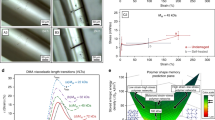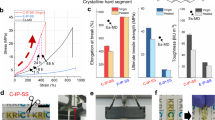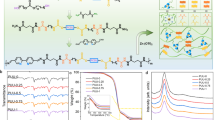Abstract
The development of polymers that can spontaneously repair themselves after mechanical damage would significantly improve the safety, lifetime, energy efficiency and environmental impact of man-made materials. Most approaches to self-healing materials require the input of external energy, healing agents, solvent or plasticizer. Despite intense research in this area, the synthesis of a stiff material with intrinsic self-healing ability remains a key challenge. Here, we show a design of multiphase supramolecular thermoplastic elastomers that combine high modulus and toughness with spontaneous healing capability. The designed hydrogen-bonding brush polymers self-assemble into a hard–soft microphase-separated system, combining the enhanced stiffness and toughness of nanocomposites with the self-healing capability of dynamic supramolecular assemblies. In contrast to previous self-healing polymers, this new system spontaneously self-heals as a single-component solid material at ambient conditions, without the need for any external stimulus, healing agent, plasticizer or solvent.
This is a preview of subscription content, access via your institution
Access options
Subscribe to this journal
Receive 12 print issues and online access
$259.00 per year
only $21.58 per issue
Buy this article
- Purchase on Springer Link
- Instant access to full article PDF
Prices may be subject to local taxes which are calculated during checkout




Similar content being viewed by others
References
Shinya, N. Frontiers of Self-Healing Materials and Applications (CMC Publishing Co., 2010).
Ghosh, S. K. Self-Healing Materials: Fundamental, Design Strategies, and Applications. (Wiley-VCH, 2009).
Chen, X. et al. A thermally re-mendable cross-linked polymeric material. Science 295, 1698–1702 (2002).
Burattini, S. et al. A healable supramolecular polymer blend based on aromatic π–π stacking and hydrogen-bonding interactions. J. Am. Chem. Soc. 132, 12051–12058 (2010).
Klukovich, H. M., Kean, Z. S., Iacono, S. T. & Craig, S. L. Mechanically induced scission and subsequent thermal remending of perfluorocyclobutane polymers. J. Am. Chem. Soc. 133, 17882–17888 (2011).
Burnworth, M. et al. Optically healable supramolecular polymers. Nature 472, 334–337 (2011).
Amamoto, Y., Kamada, J., Otsuka, H., Takahara, A. & Matyjaszewski, K. Repeatable photoinduced self-healing of covalently cross-linked polymers through reshuffling of trithiocarbonate units. Angew. Chem. Int. Ed. 50, 1660–1663 (2011).
Ghosh, B. & Urban, M. W. Self-repairing oxetane-substituted chitosan polyurethane networks. Science 323, 1458–1460 (2009).
Toohey, K. S., Sottos, N. R., Lewis, J. A., Moore, J. S. & White, S. R. Self-healing materials with microvascular networks. Nature Mater. 6, 581–585 (2007).
White, S. R. et al. Autonomic healing of polymer composites. Nature 409, 794–797 (2001).
Wang, Q. et al. High-water-content mouldable hydrogels by mixing clay and a dendritic molecular binder. Nature 463, 339–343 (2010).
South, A. B. & Lyon, L. A. Autonomic self-healing of hydrogel thin films. Angew. Chem. Int. Ed. 49, 767–771 (2009).
Imato, K. et al. Self-healing of chemical gels cross-linked by diarylbibenzofuranone-based trigger-free dynamic covalent bonds at room temperature. Angew. Chem. Int. Ed. 50, 1–5 (2011).
Montarnal, D., Tournilhac, F., Hidalgo, M., Couturier, J.-L. & Leibler, L. Versatile one-pot synthesis of supramolecular plastics and self-healing rubbers. J. Am. Chem. Soc. 131, 7966–7967 (2009).
Cordier, P., Tournilhac, F., Soulie-Ziakovic, C. & Leibler, L. Self-healing and thermoreversible rubber from supramolecular assembly. Nature 451, 977–980 (2008).
Syrett, J. A., Becer, C. R. & Haddleton, D. M. Self-healing and self-mendable polymers. Polym. Chem. 1, 978–987 (2010).
Murphy, E. B. & Wudl, F. The world of smart healable materials. Prog. Polym. Sci. 35, 223–251 (2010).
Burattini, S., Greenland, B. W., Chappell, D., Colquhoun, H. M. & Hayes, W. Healable polymeric materials: a tutorial review. Chem. Soc. Rev. 39, 1973–1985 (2010).
Sottos, N. R. & Moore, J. S. Materials chemistry: spot-on healing. Nature 472, 299–300 (2011).
Bergman, S. D. & Wudl, F. Mendable polymers. J. Mater. Chem. 18, 41–62 (2008).
Chen, X., Wudl, F., Mal, A. K., Shen, H. & Nutt, S. R. New thermally remendable highly cross-linked polymeric materials. Macromolecules 36, 1802–1807 (2003).
Ciferri, A. Bond scrambling and network elasticity. Chem. Eur. J. 15, 6920–6925 (2009).
Holden, G., Kricheldorf, H. R. & Quirk, R. P. (eds) Thermoplastic Elastomers 3rd edn (Hanser, 2004).
Borisov, O. V. & Zhulina, E. B. Amphiphilic graft copolymer in a selective solvent: intramolecular structures and conformational transitions. Macromolecules 38, 2506–2514 (2005).
KoSovan, P. et al. Amphiphilic graft copolymers in selective solvents: molecular dynamics simulations and scaling theory. Macromolecules 42, 6748–6760 (2009).
Patten, T. E., Xia, J., Abernathy, T. & Matyjaszewski, K. Polymers with very low polydispersities from atom transfer radical polymerization. Science 272, 866–868 (1996).
Burchard, W. Static and dynamic light scattering from branched polymers and biopolymers, in Light Scattering from Polymers Vol. 48, 1–124 (Springer, 1983).
Sijbesma, R. P. et al. Reversible polymers formed from self-complementary monomers using quadruple hydrogen bonding. Science 278, 1601–1604 (1997).
Folmer, B. J. B., Sijbesma, R. P., Versteegen, R. M., van der Rijt, J. A. J. & Meijer, E. W. Supramolecular polymer materials: chain extension of telechelic polymers using a reactive hydrogen-bonding synthon. Adv. Mater. 12, 874–878 (2000).
Zosel, A. & Ley, G. Influence of crosslinking on structure, mechanical properties, and strength of latex films. Macromolecules 26, 2222–2227 (1993).
Acknowledgements
This work was partially supported by the US Department of Energy, Division of Materials Sciences (award no. DE-FG02-04ER46162), corporate gifts and the University of California, Irvine. The authors thank Youli Li at the University of California, Santa Barbara, for assistance with using SAXS at the MRL Central Facilities at UC Santa Barbara supported by the MRSEC Program of the NSF (award no. DMR05-20415).
Author information
Authors and Affiliations
Contributions
Z.G., Y.C. and A.M.K. planned the experiments, Y.C., A.M.K. and G.A.W. conducted the experiments, Z.G., Y.C. and A.M.K. analysed the data, and Z.G., A.M.K., Y.C. and G.A.W. wrote the paper.
Corresponding author
Ethics declarations
Competing interests
The authors declare no competing financial interests.
Supplementary information
Supplementary information
Supplementary information (PDF 1214 kb)
Supplementary Movie 1
Supplementary Movie 1 (MOV 5557 kb)
Rights and permissions
About this article
Cite this article
Chen, Y., Kushner, A., Williams, G. et al. Multiphase design of autonomic self-healing thermoplastic elastomers. Nature Chem 4, 467–472 (2012). https://doi.org/10.1038/nchem.1314
Received:
Accepted:
Published:
Issue Date:
DOI: https://doi.org/10.1038/nchem.1314
This article is cited by
-
pH-Responsive polyethyleneimine hydrogel based on dynamic covalent bonds
Journal of Polymer Research (2023)
-
Preparation and properties of self-healing polyurethane based on disulfide and hydrogen bonding
Carbon Letters (2023)
-
Self healing approaches in polymeric materials-an overview
Journal of Polymer Research (2023)
-
Intrinsic Self-Healing Chemistry for Next-Generation Flexible Energy Storage Devices
Nano-Micro Letters (2023)
-
Repulsive segregation of fluoroalkyl side chains turns a cohesive polymer into a mechanically tough, ultrafast self-healable, nonsticky elastomer
Scientific Reports (2022)



